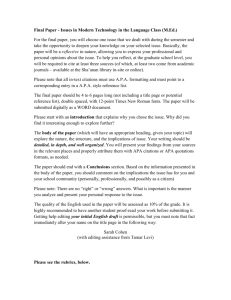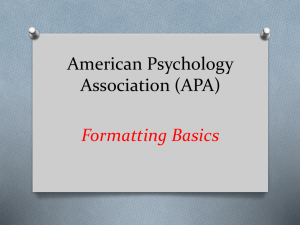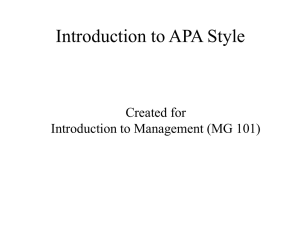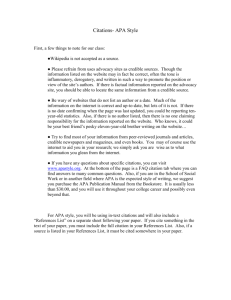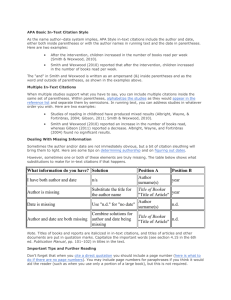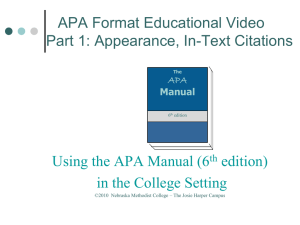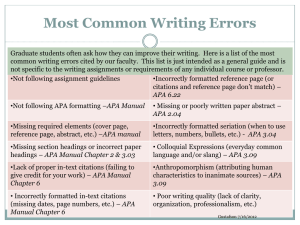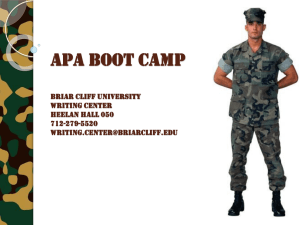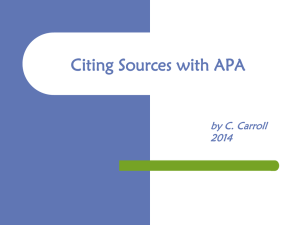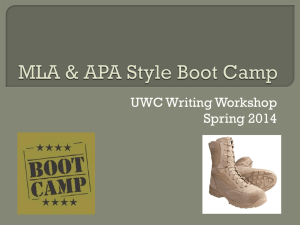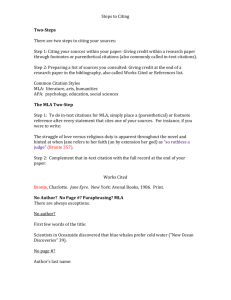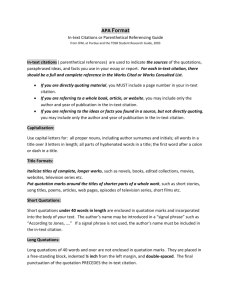APA Style? - lulibrary
advertisement
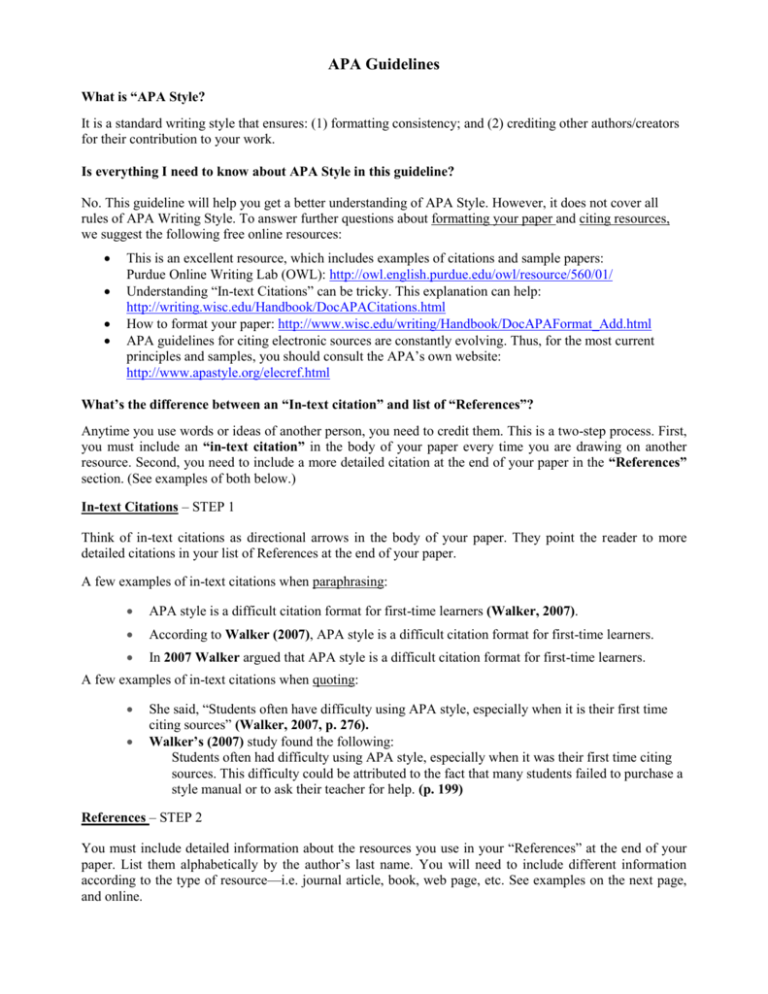
APA Guidelines What is “APA Style? It is a standard writing style that ensures: (1) formatting consistency; and (2) crediting other authors/creators for their contribution to your work. Is everything I need to know about APA Style in this guideline? No. This guideline will help you get a better understanding of APA Style. However, it does not cover all rules of APA Writing Style. To answer further questions about formatting your paper and citing resources, we suggest the following free online resources: This is an excellent resource, which includes examples of citations and sample papers: Purdue Online Writing Lab (OWL): http://owl.english.purdue.edu/owl/resource/560/01/ Understanding “In-text Citations” can be tricky. This explanation can help: http://writing.wisc.edu/Handbook/DocAPACitations.html How to format your paper: http://www.wisc.edu/writing/Handbook/DocAPAFormat_Add.html APA guidelines for citing electronic sources are constantly evolving. Thus, for the most current principles and samples, you should consult the APA’s own website: http://www.apastyle.org/elecref.html What’s the difference between an “In-text citation” and list of “References”? Anytime you use words or ideas of another person, you need to credit them. This is a two-step process. First, you must include an “in-text citation” in the body of your paper every time you are drawing on another resource. Second, you need to include a more detailed citation at the end of your paper in the “References” section. (See examples of both below.) In-text Citations – STEP 1 Think of in-text citations as directional arrows in the body of your paper. They point the reader to more detailed citations in your list of References at the end of your paper. A few examples of in-text citations when paraphrasing: APA style is a difficult citation format for first-time learners (Walker, 2007). According to Walker (2007), APA style is a difficult citation format for first-time learners. In 2007 Walker argued that APA style is a difficult citation format for first-time learners. A few examples of in-text citations when quoting: She said, “Students often have difficulty using APA style, especially when it is their first time citing sources” (Walker, 2007, p. 276). Walker’s (2007) study found the following: Students often had difficulty using APA style, especially when it was their first time citing sources. This difficulty could be attributed to the fact that many students failed to purchase a style manual or to ask their teacher for help. (p. 199) References – STEP 2 You must include detailed information about the resources you use in your “References” at the end of your paper. List them alphabetically by the author’s last name. You will need to include different information according to the type of resource—i.e. journal article, book, web page, etc. See examples on the next page, and online. Type of Source Sample Reference List Entry Book: basic form; first edition, single author, read in print Last Name, First Initial. Middle Initial. (publication date). Title in italics: Capitalize the first word and the first word after a colon. Place of publication: Publisher. Baxter, C. R. (1997). Race equality in health care and education. Philadelphia: Ballière Tindall. Book: basic form, later edition, two authors, read in print Hyde, J. S.,& Delamater, J. (2008). Human sexuality (10th ed.) New York: McGraw-Hill. Encyclopedia entry Bergmann, P. G. (1993). Relativity. In The new encyclopedia britannica (Vol. 26, pp. 501-508). Chicago: Encyclopedia Britannica. Chapter in edited work: print Curtin, J. J., & Lang, A. R. (2007). Alcohol and emotion: Insights and directives from affective science. In J. Rottenberg & S. L. Johnson (Eds.), Emotion and psychopathology: Bridging affective and clinical science (pp. 191-213). Washington, DC: American Psychological Association. Dissertation: unpublished dissertation, obtained from database Hostetter, Autumn B. (2008). Mind in motion: The gesture as simulated action framework (Doctoral dissertation, University of Wisconsin-Madison). Available from ProQuest Dissertations and Thesis database. (UMI No. 3327832). Government report: corporate author; read online National Institute of Mental Health. (2009). Anxiety disorders (NIH Publication No. 09-3879). Retrieved from National Institute of Mental Health website: http://www.nimh.nih.gov/health/publications/anxietydisorders/nimhanxiety.pdf Journal article: basic form; two authors; read online, with doi Gaudio, J. L., & Snowdon, C. T. (2008). Spatial cues more salient than color cues in cotton-top tamarins (Saguinus oedipus) reversal learning. Journal of Comparative Psychology, 122, 441-444. doi: 10.1037/07357036.122.4.441 (italicize the journal title and volume number; include the page number range) Journal article: basic form; single author; print Alibali, M. W. (1999). How children change their minds: Strategy change can be gradual or abrupt. Developmental Psychology 35, 127-145. Murray, M. E. (2001). Outcomes of concurrent utilization review. Nursing Economics, 19, 17-23. Journal article: journal paginated by issue; 3-6 authors; read online, with doi Alibali, M. W., Phillips, K. M. O., & Fischer, A. D. (2009). Learning new problem-solving strategies leads to changes in problem representation. Cognitive Development, 24, 89-101. doi:10.1016/j.cogdev.2008.12.005 Magazine article: print Park, A. (2009, Sept. 14). A shot at cancer. Time 174(10), 32-39. Newspaper article: read online, no doi Barringer, F. (2009, Sept. 14). Hawaii tries green tools in remaking power grid. The New York Times. Retrieved from http://www.nytimes.com Arledge, E. (Producer & Director). (2009). Autism genes [DVD]. Available from http://www.pbs.org/wgbh/nova/sciencenow/ Video or DVD Web site: no author, no date of publication. If there is no author, title moves to the first spot. Use retrieval date only because the content at that address likely changes. Research Initiatives. (n.d.). Retrieved January 11, 2007, from MIT, Comparative Media Studies website, http://cms.mit.edu/research/index.php Blog Posting Lopez-Duran, N. (2009, August 27). Re: Gender and age differences in the symptomatology of child depression [Web log message]. Retrieved from Child Psychology Research Blog, http://www.child-psych.org/
